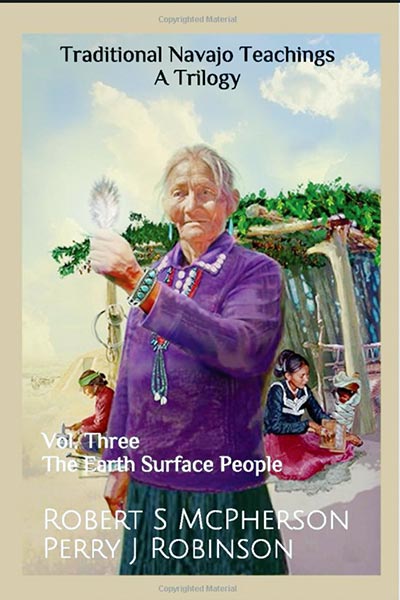
Final book in trilogy is handbook for Diné life
By Cindy Yurth
Special to the Times
CHINLE
While the land within the four sacred mountains is beautiful, sacred and beloved to the Diné, no one would say it’s an easy place to live.

Submitted
Cover for book “Traditional Navajo Teachings A Trilogy” by Robert S McPherson and Perry J Robinson.
To survive in the extremes of the high desert, a society had to adhere to strict discipline. Everyone from the tiniest child to the oldest grandmother had a special role and was expected to contribute to their family’s health and prosperity.
In turn, because of the elaborate clan system, nobody could say they lacked a family or didn’t belong.
In the third and final volume of their trilogy “Traditional Navajo Teachings,” historian Robert McPherson and hataałii Perry Robinson take on “The Earth Surface People.”
The book is arranged chronologically like a human lifespan, starting with customs surrounding childbirth, progressing through childhood and puberty for each gender, marriage and raising children, old age and death.
Some attention is also devoted to the nádleeh and their unique role, although Robinson admits he doesn’t know the particulars of the ceremonies associated with those who wish to transition and notes that very few medicine men these days do.
There is a proper and improper way to do everything in Diné life, and Robinson laments that these mores are no longer followed — with disastrous results including drought and COVID-19.
That is the main reason he chose to share his teachings at this time.
The book also includes parts of the body, which the Navajo view almost as people living within a person, as Robinson describes it.
They have much to teach us and can even be prayed to, especially when a person is sick.
For instance, “On the outside of a clenched fist, there are the Four Sacred Mountains sitting on top. The veins found beside and between the knuckles carry the water running off these mountains to the health …
“(I)f a person balls his fists and strikes someone, the person who hits will destroy everything those fingers have worked for,” Robinson said. “It is like taking the Four Sacred Mountains and abusing them so that you will never get those good things back.”
Illnesses and their cures are also covered.
Toward the end is a very interesting comparison of Diné and Western medicine, and reflections on the three epidemics that have stalked the Navajo people — the Spanish Flu of 1918, hantavirus and coronavirus — all of which, Robinson notes, occurred after contact with bilagáana.
McPherson provides some other traditional perspectives on the coronavirus epidemic, referencing a series that ran in the Navajo Times.
Of the three volumes in the trilogy — “Sacred Narratives and Ceremonies,” “The Natural World” and “The Earth Surface People” — this final book may be the most useful to young Navajos trying to find their place in their families and their tribe — although Diné teachings are sometimes harsh and they may not like everything they read.
For non-Navajos, it provides a window into a culture that is evolving, but sticking to its values of hard work and connectedness, and perhaps some words to live by.
As Robinson says, we are all Earth-surface people.








 Highway 264,
Highway 264, I-40, WB @ Winslow
I-40, WB @ Winslow